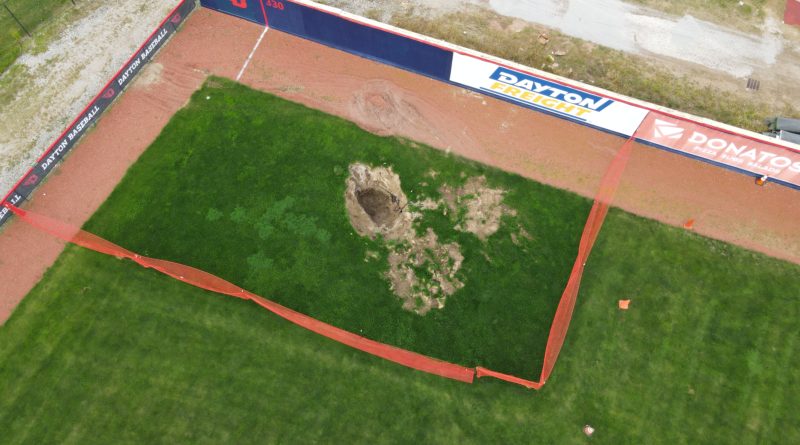Future of Woerner Field being evaluated after sinkhole opens in left field
A sinkhole that opened in left field this summer kickstarted an investigation into the condition and future of Flyers baseball’s home field. Photo courtesy of Keegan Gupta, Flyer News.

Peter Burtnett | Sports Editor
Woerner Field, the home stadium of the University of Dayton baseball team located less than one mile off campus, is currently under evaluation after a sinkhole opened in left field this summer.
Scott DeBolt, who is officially Executive Director of UD Arena but also oversees all other athletic facilities at Dayton, is leading the investigation of the condition of the field and other potential options.
Once on the site of a landfill, Woerner Field and the football team’s Jerry Von Mohr Practice Field were built in 2003 with the understanding that the ground underneath the playing surfaces was “suspect.”
DeBolt, who has been at Dayton since 2013 but has over 27 years of experience in event and facility management, said when the facilities were built almost two decades ago, they were done to make sure the ground was “firm enough” and “structurally sound.”
“We’ve experienced, over the last 18 years, certain areas on the football field and the baseball field settling,” DeBolt said.
Defined as, “Sedimentation; i.e the settling out of solid particles from suspension in water,” by Britannica, settling can also, “refer to movement of structures located above deep beds of soft clay,” and can “continue for several years after a structure is completed.”
According to DeBolt, this settling happens under the fields at UD because things like wood underneath the fields decays over time, creating erosion. Aquifers also run underground most of the land under the fields and around the area, including under UD Arena.
“So you get wash-outs underneath (the field),” DeBolt said. “So we’ve dealt with most of them that were pretty easy, you know, settling of three to six inches is not uncommon at certain times and all that. But just recently there was a larger one in left field out there that we said, okay, we got to take a little bigger look at this.”
A potential solution that DeBolt said has been talked about for three years is turfing Woerner Field. The sinkhole “kickstarted” those discussions, and the facility management team is currently “evaluating the cost.”
“Whether we put a temporary fix, and turf only the infield, or turf the infield and the outfield, or do a much larger excavation of the ground and all that (is being considered). The problem is, anytime you open up the ground you’re always suspect to finding more and creating more openings underneath. You know the top three, four feet are pretty solid, but anything under that gets a little suspect.”
DeBolt joked that the baseball team will have some really good right fielders because the left field area around the sinkhole and a center field area around a bore hole (used to help evaluate the ground under the field) is fenced off.

But DeBolt said the facility management team is hoping to make a decision in the next 30 to 60 days on whether to “do something here immediately or wait until after the spring season next year.”
If the project started today (interview took place Oct. 14), DeBolt said aside from supply chain delays, as seen with getting turf for Jerry Von Mohr Practice Field, and problems with redoing drainage and evaluating the ground, the project would be done in early-mid April. However, DeBolt said that timeline would only exist in a “perfect world.”
Instead, while they practice on the turf on Von Mohr or on fields around the area, DeBolt and the athletic department are having initial conversations with the Dayton Dragons, Single A Minor League Baseball affiliate of the Cincinnati Reds, to play at their home stadium, Day Air Ballpark. The Flyers played three games at the ballpark last year, but they are also looking at “other facilities.”
“Anything’s possible at this point in time,” DeBolt said. “Nothing’s definitive until we make a determination of what we’re going to do. Because again, if we say okay, let’s put a temporary fix on this to get us through May, and then we’ll do it all over the summer, and doing the project when it’s better weather, when we can speed things up a little bit.”
The temporary fix for the sinkhole would likely be to use “slurry fill” according to DeBolt. Slurry fill is used to help harden up the ground in the sinkhole, and the solution would then be to backfill the sinkhole and add “normal drainage and turf on top of that, just to make it more stable.” DeBolt said this solution would get the Flyers through the next two to three years, but it depends on whether they decide to use slurry fill.
As of now, no official decision has been made, but the university is working towards finding a solution to the sinkhole at Woerner Field.
For more sports news like Flyer News on Facebook and follow us on Twitter (@FlyerNews & @FlyerNewsSports) and Instagram (@flyernews)

